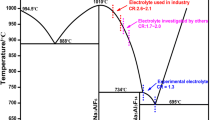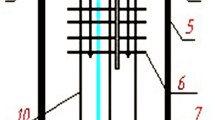Abstract
The rate of dissolution of electrolytically deposited aluminium was determined by the method of current reversal chronopotentiometry at a tungsten electrode in NaF−AlF3−Al2O3 melts of varying NaF/AlF3 molar ratios or cryolite ratios (CR). The temperature was maintained at 1031±3°C and the alumina content at 4 wt%. More accurate data were obtained by introducing delay times of various lengths (at zero current) between the cathodic and anodic current pulses, compared to direct current reversal chronopotentiometry with varying forward (deposition) times. The rate of aluminium dissolution increased with increasing NaF/AlF3 molar ratio, the curve showing an inflexion in the vicinity of CR=3. This inflexion indicates two dissolution mechanisms, one being predominant depending on the CR. The main reaction in acidic melts (CR<3) may be represented by
while in basic melts (CR>3)
is the likely dominant mechanism. For 0.8<CR<5.7 the rate of dissolution is of the order of 10−7 mol cm−2s−1.
Similar content being viewed by others
References
K. Grjotheim et al. ‘Aluminium Electrolysis’, 2nd edn, Aluminium-Verlag, Dusseldorf (1982).
K. Grjotheim and H. Kvande, ‘Understanding the Hall-Heroult Process for Aluminium Production’, Aluminium-Verlag, Dusseldorf (1986).
K. Grjotheim and J. J. Welch, ‘Aluminium Smelter Technology’, Aluminium-Verlag, Dusseldorf (1980).
R. Oblakowski and Z. Orman,Arch. Hutn. 18 (1973) 39.
O. P. Bersimenko and M. M. Vetyukov,Zh. Prikl. Khim. 40 (1967) 195;J. Appl. Chem. U.S.S.R. (Eng. Trans.) 40 (1967) 177.
O. P. Bersimenko and M. M. Vetyukov,Sov. J. Non-Ferrous Met. 8 (1967) 71.
O. P. Bersimenko,Tr. Leningrad Politekh. Inst. 272 (1967) 73, inChem. Abstr. 70 (1967) 14756h.
J. J. Duruz and D. Landolt,J. Appl. Electrochem. 15 (1985) 393.
J. J. Duruz, G. Stehle and D. Landolt,Electrochim. Acta 26 (1981) 771.
K. A. Bowman, Doctorate Dissertation, University of Tennessee (1977).
L. F. Mondolfo, ‘Aluminium Alloys: Structure and Properties’, Butterworths, London (1976) pp. 394–396.
E. Sum and M. Skyllas-Kazacos, unpublished data.
R. K. Jain, H. C. Gaur and B. J. Welch,J. Electroanal. Chem. 79 (1977) 211.
J. Thonstad and S. Rolseth,Electrochim. Acta 23 (1978) 233.
L. N. Lozhkin and A. P. Popov,J. Appl. Chem. U.S.S.R. (Engl. Trans.) 41 (1968) 2277.
K. Yoshida, T. Ishihara and M. Yokoi,Trans. Met. Soc. AIME 242 (1968) 231.
R. Odegard, A. Sterten and J. Thonstad,Light Metals (1987) 389.
F. Lantelme, D. Damianacos and M. Chemla,J. Electrochem. Soc. 127 (1980) 498.
Z. Qiu, N. Fong and K. Grjotheim,Light Metals (1983) 357.
Author information
Authors and Affiliations
Rights and permissions
About this article
Cite this article
Sum, E., Skyllas-Kazacos, M. Aluminium dissolution in NaF-AlF3-Al2O3 systems. J Appl Electrochem 18, 731–738 (1988). https://doi.org/10.1007/BF01016900
Received:
Revised:
Issue Date:
DOI: https://doi.org/10.1007/BF01016900




